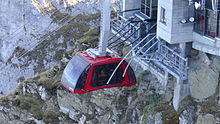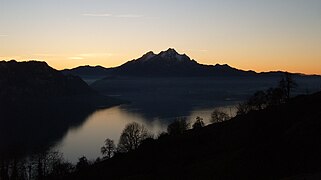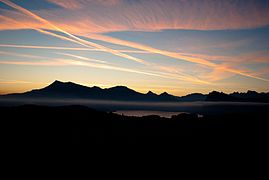
Pilatus, also often referred to as Mount Pilatus, is a mountain massif overlooking Lucerne in Central Switzerland. It is composed of several peaks, of which the highest – 2128 m (6982 ft) is named Tomlishorn
|
PILATUS Highest point |
|
|---|---|
| Peak | Tomlishorn |
| Elevation | 2132 m (6995 ft) |
| Prominence | 585 m (1919 ft) |
| Isolation | 16.7 km (10.4 mi) |
| Parent peak | Brienzer Rothorn |
How is the Geography and transport for Pilatus ?

Newest aerial cable car (called Dragon Ride) arriving at top station of Pilatus
The whole mountain range stretches at least from the Lopper just opposite from Stansstad to the east as far as at least to the Mittaggüpfi (1917 m [6289 ft]) and the Risetestock (1,759 m [5771 ft]) to the west on the border between LU and OW
The highest peak, Tomlishorn (2128 m [6982 ft]) and the other peaks such as Widderfeld (2076 m [6811 ft]) even further west than the Tomlishorn on the border between LU and OW Matthorn (2040 m [6690 ft]) to the south the Klimsenhorn (1906 m [6253 ft]) to the north (UW) and Rosegg (1974 m [6476 ft]) and Windegg (1673 m [5489 ft]) to the east both on the border of UW and OW should only be approached with appropriate Alpine hiking equipment
Jurisdiction over the massif is divided between the cantons of Obwalden (OW), Nidwalden (NW) and Lucerne (LU).
The main peaks are right on the border between Obwalden and Nidwalden
The top can be reached with the Pilatus Railway, the world’s steepest cogwheel railway from Alpnachstad, operating from May to November (depending on snow conditions) and the whole year with the aerial panorama gondolas and aerial cableways from Kriens
Tomlishorn is located about 1.3 km (0.81 mi) to the southeast of the top cable car and cog railway station
Two other peaks, closer to the stations are called Esel (Donkey, 2118 m [6949 ft]) which lies just east over the railway station, the one on the west side is called Oberhaupt (Head-Leader, 2105 m [6906 ft])
During the summer, the “Golden Round Trip” — a popular route for tourists — involves taking a boat from Lucerne across Lake Lucerne to Alpnachstad, going up on the cogwheel railway, coming down on the aerial cableways and panorama gondolas, and taking a bus back to Lucerne
What is the history of Pilatus and Why the Dragon Symbol for Mount Pilatus ?
A few different local legends about the origin of the name exist
- One claims that Pilatus was named so because Pontius Pilate was buried there. However, a similar legend is told of Monte Vettore in Italy
- Another is that the mountain looks like the belly of a large man, Pilate, lying on his back and was thus named for him. The name may also be derived from “pileatus,” meaning “cloud-topped.”
- A medieval legend had dragons with healing powers living on the mountain.
- A chronicle from 1619 reads: ‘as I was contemplating the serene sky by night, I saw a very bright dragon with flapping wings go from a cave in a great rock in the mount called Pilatus toward another cave, known as Flue, on the opposite side of the lake’
- This legend was the inspiration for Steven Reineke’s famous concert band piece, Pilatus: Mountain of Dragons
- Numbered amongst those who have reached its summit are Conrad Gessner, Theodore Roosevelt, Arthur Schopenhauer (1804), Queen Victoria and Julia Ward Howe (1867)
- The mountain has fortified radar (part of the Swiss FLORAKO system) and weather stations on the Oberhaupt summit, not open to the public view and used all year round

Pilatus and Lake Lucerne

A view of the Hotel and Restaurant, the cog railway top station, and the Esel peak in the back

A view from the mountain (winter)

A view from the cog-wheel railway

View from Pilatus towards mount Rigi and Lake Lucerne

Pilatus seen from Stanserhorn funicular
Describe the Pilatus Railway – the Worlds Steepest Cogwheel Railway !
- The Pilatus Railway (German: Pilatusbahn / PB) is a mountain railway in Switzerland and is the steepest rack railway in the world, with a maximum gradient of 48% and an average gradient of 35%
- The line runs from Alpnachstad, on Lake Lucerne to a terminus near the Esel summit of Pilatus at an elevation of 2073 m (6801 ft) which makes it the highest railway in the canton of Obwalden and the second highest in Central Switzerland after the Furka line
- At Alpnachstad, the Pilatus Railway connects with steamers on Lake Lucerne and with trains on the Brünigbahn line of Zentralbahn
| Pilatus Railway | |
|---|---|

Pilatus Railway tracks are laid without ballast
|
|
| Overview | |
| Native name | Pilatusbahn |
| Status | Operational |
| Locale | Obwalden, Switzerland |
| Termini | Alpnachstad Pilatus Kulm |
| Stations | 5 |
| Services | 1 |
| Operation | |
| Opened |
4 June 1889 (Steam), reopened 15 May 1937 |
| Technical | |
| Line length | 4.6 km (2.86 mi) |
| Track gauge | 800 mm (2 ft 7 1⁄2 in) |
| Electrification | 1550 V, DC overhead line |
| Operating speed |
9 km/h (5.6 mph) downhill / About 10 km/h (6.2 mph) uphill |
| Highest elevation | 2073 m (6801 ft) |
| Maximum incline | 48 % |
| Rack system | Locher |
Gallery

Share of the Pilatus Railway Company, issued 1. July 1888; founder’s share

The train ready to leave, June 4, 1889

Pilatus Railway Time Table from 1905

A railcar at the summit station

Alpnachstad station; note the inclination of the platform behind the building

The Locher system rack and pinion

A turnout consisting of a bridge that rotates about its lengthwise axle

The two row transfer table in Pilatus Railway, one edge also serving as a passenger platform
Describe the Operation of Pilatus Railway ?
- The line is 4.6 km (2.86 mi) long, climbs a vertical distance of 1629 m (5344 ft) and is of 800 mm (2 ft 7 1⁄2 in) gauge
- Because of the rack-system, there are no conventional points or switches on the line – only rotary switches (see photograph above) and traversers
- All rails are laid on solid rock, securing rails by high-strength iron ties attached to the rock, without using any ballast
- The line still uses original rack rails that are now over 100 years old
- While they have worn down, it was discovered that this can be fixed by simply turning the rails over, providing a new wearing surface that would be sufficient for the next century as well
- The cars’ electric motors are used as generators to brake the car during descent, but this electricity is not reused — it is just dissipated as heat through resistance grids
- Originally, the steam engines were used as compressors to provide dynamic braking, since the use of friction brakes alone is not practical on such steep slopes

